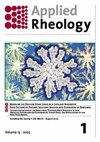In-line measurement and modeling of temperature, pressure, and blowing agent dependent viscosity of polymer melts
IF 1.8
4区 工程技术
Q1 MECHANICS
引用次数: 1
Abstract
Abstract During processing and bubble growth processes, the melt viscosity changes with temperature, pressure, and blowing agent concentration. Therefore, measurement and prediction methods for viscosity characterization in terms of temperature, pressure, and blowing agent dependency are needed. This study demonstrates the applicability of in-line viscosity measurements during the foam injection molding process and a model for viscosity superposition and prediction. In the present study, polystyrene and a modified polylactide for foaming applications with nitrogen as blowing agent are investigated. By changing the injection speed, temperature, and blowing agent concentration, the process conditions are varied, and thus the resulting pressure drops within the in-line measurement die. The calculated shear rates and viscosities are shifted to a master curve by the application of superposition principles. The viscosity dependency on temperature is described by the Arrhenius equation, the pressure by the Barus equation, and for the blowing agent concentration, a novel Barus-like equation was derived and applied. The prediction of the master curve viscosity function was achieved by the power-law model in combination with the superposition principles and showed good agreement with the shifted in-line data. Finally, the in-line measurements and viscosity predictions are validated by comparing them to rotational and capillary rheometer measurements.聚合物熔体温度、压力和发泡剂相关粘度的在线测量和建模
摘要在加工和气泡生长过程中,熔体粘度随温度、压力和发泡剂浓度的变化而变化。因此,需要在温度、压力和发泡剂依赖性方面的粘度表征的测量和预测方法。本研究证明了在线粘度测量在泡沫注射成型过程中的适用性,以及粘度叠加和预测模型。本研究以氮气为发泡剂,研究了聚苯乙烯和改性聚乳酸的发泡应用。通过改变注射速度、温度和发泡剂浓度,工艺条件发生变化,从而在线测量模具内产生压降。通过应用叠加原理,将计算出的剪切速率和粘度转换为主曲线。粘度对温度的依赖性由Arrhenius方程描述,压力由Barus方程描述,对于发泡剂浓度,导出并应用了一个新的类Barus方程。幂律模型结合叠加原理实现了主曲线粘度函数的预测,与在线偏移数据吻合良好。最后,通过将在线测量和粘度预测与旋转流变仪和毛细管流变仪测量进行比较,验证了在线测量和粘性预测。
本文章由计算机程序翻译,如有差异,请以英文原文为准。
求助全文
约1分钟内获得全文
求助全文
来源期刊

Applied Rheology
物理-力学
CiteScore
3.00
自引率
5.60%
发文量
7
审稿时长
>12 weeks
期刊介绍:
Applied Rheology is a peer-reviewed, open access, electronic journal devoted to the publication in the field of applied rheology. The journal provides the readers with free, instant, and permanent access to all content worldwide; and the authors with extensive promotion of published articles, long-time preservation, language-correction services, no space constraints and immediate publication.
 求助内容:
求助内容: 应助结果提醒方式:
应助结果提醒方式:


